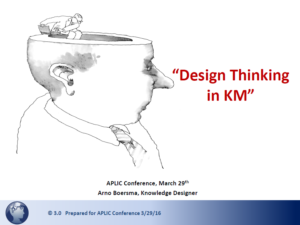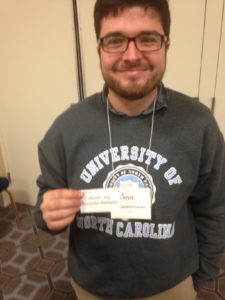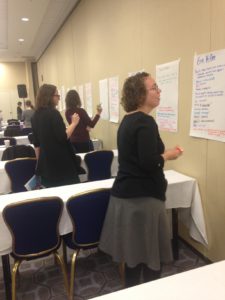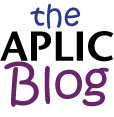Design Thinking in KM
Tuesday, March 29, 2016
10:45 AM-12:00 PM
Speaker: Arno Boersma, World Bank Group
At most organizations, managing knowledge is an ongoing challenge. Knowledge management is often not where we want it to be and some would say KM is grasping for its last breath. Design Thinking – a “human-centered” approach used to create new product or services solutions – could be its much-needed lifesaver. It has everything KM needs to survive and even thrive. By applying the fundamental characteristics of Design Thinking – experimental, collaborative, human-centered, and optimistic – to KM initiatives, a powerful combination emerges. The presentation will underline this much-needed combination by way of real life examples.
Interested in Knowledge Management since the 1990s, Arno Boersma has also been focusing on Design Thinking principles over the past few years. This requires a focus on more human, behavioral side of Knowledge Management. A Knowledge Designer designs knowledge so organizations perform better.
Many thanks to Liz Nugent for sharing her notes, below:
Click here to view a PDF of Mr. Boersma’s presentation.
To do KM well, you should pull from many disciplines: Information management, IT, HR, strategy management. KM is really about helping people get the ability to act.
Two things have changed KM: technology and neuroscience
There are five critical success factors to do KM well:
- Ensure management commitment
- Think big, then start small
- Show quick, tangible results
- Use what you have, before you invest
- It’s about people, not technology
KM needs a jolt because too often the any of the five critical success factors are lacking:
- Too abstract
- No link to business
- Too technology-driven
- No owner
- People don’t want to change
- People don’t want to share
- Not helping the end-user
Understanding people means understanding (Innovation professor Mathieu Weggeman):
- K + I * ESA
- Knowledge =Information (codified)* Experience, Skills, Attitude (tacit, sharing vs. door closed). Attitude is the biggest challenge. “It’s about chefs, not recipes.”
Understanding people means understanding neuroscience (neuroscientist David Eagleman):
- We don’t always know what we know
- Knowledge is never singular
- “Encourage knowledge-sharing, connections and conversations” (make sure people meet others as often as possible)
Design thinking to the rescue!
- Many organizations are still struggling with KM, and there are still a lot of unhappy people with the concept (because IT may have hijacked KM practice in an organization)
- Design thinking has caught up with KM
- Design thinking has gone mainstream (Harvard Business Review article, NY Times IBM article)
- What is sweet spot between KM and DT?
- DT is innovation inspired by people: experimental, collaborative (look at stakeholders you might not suspect; throw wide net as far as stakeholders), human-centric (make sure you know what people want), optimistic (have to believe you can create change)
Examples of application to KM
- Experimentation – make it an iterative process, not linear process of roadmap with milestones
- Collaboration – be more inclusive, larger stakeholder field, break silos in organization, including position of KM
- Human centric end user focus, not tech or supply driven, see what they do, don’t just survey
- Optimism – try things, learn and adjust, not afraid to fail, capture lessons learned
Case study: Knowlympics Competition
- Objective: solicit great examples of KM for the field / operations
- 160 field projects across World Bank – turned into a booklet that was made available to staff
- Keynote given by Captain of Jamaican bobsled team
Case study: Global Knowledge Flows
- Objective: ensure effective knowledge transfers across the globe
- Interactive program of embedding knowledge transfer principles and policy among local staff based on in-depth cultural insights
Case study: Large-scale learning event
- Objective: design learning events in ways that the knowledge and learnings are absorbed and applied
- NOT: one-way lectures, death by PPT, large plenaries, panel talks, one-off moment. What you hear doesn’t stick – consider the forgetting curve (Donald Clark), which says that after one month, you retain about 20% of information provided
- The event was collaborative, bite-sized, practical, staff-to-staff, small groups, bottom-up, long-term. Internal Wikipedia on lessons from event still being tapped.
Lessons from these examples, in short…
- Do not just ask people to fill in a database, adopt a policy, or sit at event
- Do not invest in a new program without knowing how your stakeholders will and want to benefit
- Do not underestimate the fact that it’s the human factor that determines success or failure in our knowledge work. This is where KM programs usually fail.
- Recommended app: “Poll anywhere” to immediately poll your audience and project live results
- “No money, no problem” workshop – looked at free tools internally and externally (library is one big resource)
Recommended resource:
- IDEO Toolkit at designkit.org
Q&A and other tips
- Ask the same question three times to get the best response!
- Where might a Knowledge Services Unit best sit within an organization? A high-level chief knowledge officer can serve as a connector that moves inside and outside the organization. The World Bank has no chief knowledge officer.
- “Ask Me Anything” web session!
- Institutional acronym list, central database of external contact names – examples of useful added value
- Free social network analysis can provide a snapshot on a specific inquiry related to just people, used to examine how people were connected
- Information audit involves more than just people





